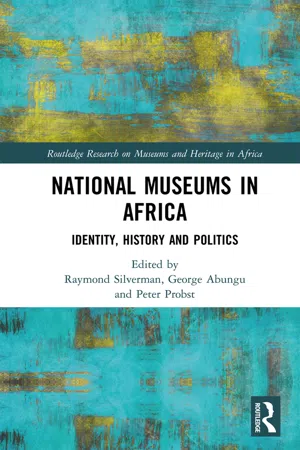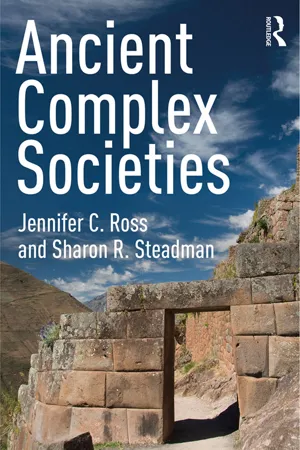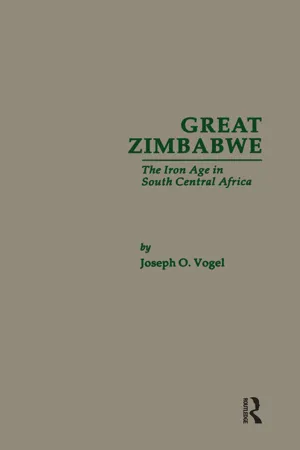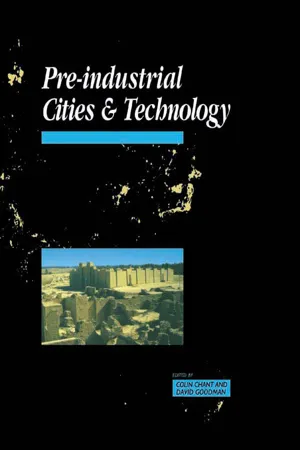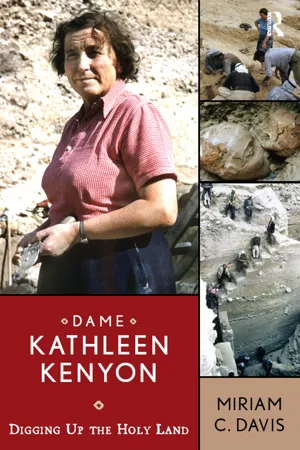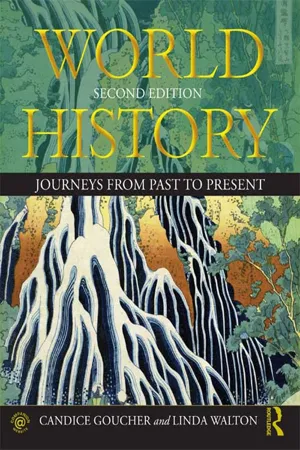History
Great Zimbabwe
Great Zimbabwe was a medieval city in southeastern Africa, known for its impressive stone structures and as a center of trade and culture. It was the capital of the Kingdom of Zimbabwe and flourished between the 11th and 15th centuries. The site is significant for its architectural achievements and its role in the history of the region.
Written by Perlego with AI-assistance
Related key terms
7 Key excerpts on "Great Zimbabwe"
- eBook - ePub
National Museums in Africa
Identity, History and Politics
- Raymond Silverman, George Abungu, Peter Probst, Raymond Silverman, George Abungu, Peter Probst(Authors)
- 2021(Publication Date)
- Routledge(Publisher)
Prominent today are the dry stone-built walls (ruins) concealed within a state-protected 720-hectare estate. However, there are over 360 similar, recorded archaeological sites located in Zimbabwe, with a few in the neighboring countries of Botswana, Mozambique and South Africa. 1 Out of the vast possibilities for interpreting Zimbabwe's pastness, controversies surrounding the origins of Great Zimbabwe came to dominate archaeological debates in the twentieth century, epitomizing the politics of the past, and a “genre of colonial archaeology” (Kuklick 1991, 162). The ruins became a conceptual springboard that shaped and re-shaped the representation and governance of archaeological sites and museums (see Garlake 1982 ; Fontein 2006a ; Mataga 2014). The colonial fantasies that the Great Zimbabwe ruins had been built by King Solomon or the Queen of Sheba, or by the Phoenicians or a spattering of other ancient non-African peoples, for gold mining, resulted in the ransacking of stone-walled ruins around the country in the 1890s and early 1900s by explorers and early settlers, particularly those of the Ancient Ruins Company Ltd (Bent 1892 ; Kuklick 1991 ; Matenga 1998). This company was authorized by the British South Africa Company (BSAC) in 1895 to mine all ruins for profit, save for Great Zimbabwe. But Great Zimbabwe was not spared, and under public pressure to stop stone ruins being ransacked, the company was dissolved in 1900 and the Ancient Monuments Protection Ordinance was passed in 1902. 2 Richard Nicklin Hall was appointed the first curator for Great Zimbabwe in 1902, the same year the ordinance was passed. He was supposed to conduct maintenance work and promote tourism - eBook - ePub
- Jennifer C. Ross, Sharon R. Steadman(Authors)
- 2017(Publication Date)
- Routledge(Publisher)
In part, this assessment is based on the status of Great Zimbabwe as a major trade center in the 14th century ce and the identification of its spectacular stone structures as palaces (Chirikure and Pikirayi 2008; Pikirayi and Chirikure 2011). However, this latter interpretation has been staunchly refuted (Huffman 2010a, 2010b, 2011). It is also argued that, while the king and wealthy elites did indeed direct trade and that the Great Zimbabwe settlement hosted a thriving market economy, the sociopolitical and economic structures, and the class structure, cannot be defined as belonging to a “state-level society” (Huffman 2010a; Pwiti 2004) but rather a complex chiefdom. Great Zimbabwe Origins Reaching a zenith in the 14th century ce, Great Zimbabwe is named for the over 300 stone enclosures (Figure 4.2) called zimbabwe, which translates to “ritual seat of a king” or, more generally, to “sacred house” (McIntosh 1998). The beauty of the stone buildings at Great Zimbabwe inspired many early visitors to believe they were built by a great and ancient civilization; one of the most popular beliefs, generated by European explorers, was that they were the site of King Solomon’s mines, famous from Biblical descriptions (Ndoro 2005). Figure 4.1 Map of Southern Africa and Sites Discussed in the Text Source : S.R. Steadman In approximately 1000 ce, changes in the rainfall pattern allowed larger settlements to emerge in the previously lightly occupied Limpopo-Zambezi region. The first substantial settlement, known as K2, had a population of about 1,500 people by 1200 ce and can be described as a ranked society (Huffman 2009). The K2 chief lived among the people, in a large circular structure with satellite buildings that may have served as kitchens and storage areas (Huffman 2005). K2 residents were involved in both agricultural and pastoralist activities, and thus sufficient rainfall in this dry area was critical - eBook - ePub
Great Zimbabwe
The Iron Age of South Central Africa
- Joseph O. Vogel(Author)
- 2019(Publication Date)
- Routledge(Publisher)
Rhodesian Prehistory 14 (1975): 21-24.Illustrated discussion of the claims made for an ancient association between Great Zimbabwe and the gold fields of King Solomon and the residence of the Queen of Sheba. Explains that the C-14 chronology of Great Zimbabwe is too recent to be associated with ancient times and that resemblances between central African architecture and sometimes cited southern Arabian structures are misleading or erroneously stated.103. Huffman, T. N. "Zimbabwe: Southern Africa's First Town." Rhodesian Prehistory 7.15 (1977): 9-14.Illustrated summary article reconstructing the cultural history of Great Zimbabwe with respect to the economic, ritual and political life of the people living there.104. Huffman, T. N. "Snakes and Birds: Expressive Space at Great Zimbabwe." African Studies 40 (1981): 131-50.Illustrated analysis of the symbolism inherent in the spatial organization of Great Zimbabwe; along with a collation of ethnographic and historical sources detailing social space in southeastern Bantu society. Examines the spatial expression of traditional Shona attitudes about status and life forces and constructs a model for observing evidence of a similar world view in archaeological remains.105. Robinson, K. R. "The Archaeology of the Rozwi." The Zambesian Past . Ed. E. Stokes and R. Brown. Manchester: Manchester University Press, 1966. 3-27.Examination of the archaeological evidence relevant to the period of Rozwi domination in Zimbabwe. Examines the ceramic evidence for continuities and the distribution of zimbabwes in space and time to conclude that the Rozwi developed autochthonously in the south and the center of the associated Zimbabwe culture moved north through time and that the emergence of the Rozwi was coincident with the first walling at Great Zimbabwe. Illustrated with two maps depicting the distribution of sites associated with either the Khami tradition or Zimbabwe culture.106. Summers, R. F. H. Zimbabwe: A Rhodesian Mystery , Johannesburg: Nelson, 1963.General review of the traditional, archaeological and historical evidence from and about Great Zimbabwe and the other stone enclosures.107. Wieschhoff, H. A. The Zimbabwe-Monomatapa Culture in Southeast Africa - eBook - ePub
- Colin Chant, David Goodman(Authors)
- 2005(Publication Date)
- Routledge(Publisher)
What went on in the city? Archaeological evidence, painstakingly reassembled after the first clumsy diggings, shows that Great Zimbabwe was a centre for metalworking. Crucibles containing copper, bronze and gold have been found. Iron-smelting produced arrow- and spear-heads. Garlake estimates that the population was somewhere between 1,000 and 2,500. The city must have built up an extensive export and import trade before it went into mysterious decline in the late fifteenth century, for fragments of Chinese pottery have been discovered. It seems likely that the city was exporting gold, via port cities, probably to Arab countries or even to China, and importing luxury goods. This in turn indicates that Great Zimbabwe was a fully-fledged, though small, city. It had emancipated itself sufficiently from subsistence activities to develop specialist metalworking trades and to set up extensive trading networks. (The nearest coast is 480 kilometres away; and Kilwa, a trading port which flourished at the same time as Great Zimbabwe, is 1,440 kilometres away.)The gold-mining connection with Great Zimbabwe indicates the possibility of the transfer of a technology from mining to building.1 Ore-bearing rocks in the mining areas were split by being heated in fires and then doused with cold water. The granite rock from which the walls of Great Zimbabwe are made tends to erode naturally into flat slabs but, in some walls, it appears to have been broken down into more precisely shaped blocks by the same method of heating and rapid cooling.1 I owe this point to Arnold Pacey.Great Zimbabwe is by far the biggest stone ruin in the region, but there are fifty or so smaller sites. At a far humbler level, wherever it occurred locally, uncut stone rubble was used fairly widely in Africa for the foundations and lower walls of buildings that were built chiefly of timber and thatch.Timber and vegetation
This brings us to the second group of materials – timber and vegetation. Until fairly recently, such perishable materials, and the buildings constructed from them, had a rather lowly place in the history of architecture. But now, driven by modes of cultural study which privilege no particular way of living and building, and by an emerging concern in the industrialized countries for the construction of ‘green’ buildings,2 interest in traditional African architecture has grown. In a book upon which I have drawn extensively in this chapter, Denyer has meticulously catalogued and analysed traditional African buildings, establishing a taxonomy of thirty-two distinct types, most of which were built from timber – usually thin laths and poles rather than hefty beams – with thatched roofs and woven fibre or mud-plastered walls (Denyer, 1978 - eBook - ePub
People of the Earth
An Introduction to World Prehistory
- Brian M. Fagan, Nadia Durrani(Authors)
- 2018(Publication Date)
- Routledge(Publisher)
From the region known as Sofala, the tentacles of the gold and ivory trade extended far inland, up the Limpopo, Sabi, and Zambezi rivers to the plateau country of the interior. For centuries, this trade was at best sporadic and on a small scale. It was a long-distance trade that merged imperceptibly with the myriad bush paths that carried essential commodities and luxuries from one village to the next. The change came after the tenth century A.D. on the coast, and sometime later in the interior, when the international demand for gold and ivory skyrocketed. It can be no coincidence that the trade with Sofala picked up dramatically as the East African coastal towns enjoyed their greatest prosperity. The chiefs of Great Zimbabwe managed to dominate the trade between the southwestern goldfields and the coast. The word Zimbabwe is either a contraction of the Shona words dzimba dza mabwe, “houses of stone,” or, more likely, of dzimba hoye, “venerated houses,” an expression used to describe chiefs’ houses or graves. Judging from archaeological data, Great Zimbabwe served both these roles (Garlake, 1973; Huffman, 1987; Pikirayi, 2017). In about A.D. 1000, Shona groups, probably direct ancestors of the present-day inhabitants of the area, settled near Great Zimbabwe (Beach, 1993). One village lay on the western end of the low hill that now dominates the site, its cattle enclosures and millet gardens spread out over the valley below. These people and their neighbors lived in good farming and cattle country, where they were able to maintain large grain surpluses and to develop great wealth on the hoof, but theirs was not a vital gold-producing area. FIGURE 16.17 The Great Enclosure or Elliptical Building at Great Zimbabwe with valley ruins in the foreground. A solid masonry Conical Tower dominates the interior and is thought to be a symbolic grain bin, an expression of chiefly power - eBook - ePub
Dame Kathleen Kenyon
Digging Up the Holy Land
- Miriam C Davis(Author)
- 2016(Publication Date)
- Routledge(Publisher)
HAPTER TWOBEGINNING IN ARCHAEOLOGYC OVERING ABOUT SIXTY ACRES , the ruins of the Great Zimbabwe are the largest ancient stone buildings in sub-Saharan Africa. From the beginning they were associated in the West with romance and treasure. The Portuguese, who probably learned of them second hand from Arab traders in the sixteenth century, attributed them to the legendary Queen of Sheba. The speculations of later European travelers, who could not believe that such impressive buildings could have been constructed by indigenous Africans, were equally wild. In the nineteenth century, German explorer Carl Mauch, the first European to view the ruins and produce a written account of them, also attributed them to the Queen of Sheba, built in imitation of Solomon’s temple with cedars of Lebanon furnished by the Phoenicians. In 1891 Theodore Bent’s investigations led him to conclude that they had been made by peoples from the Arabian Peninsula. Journalist Richard Hall dug at the site from 1902 to 1904. His findings, not surprisingly, mirrored that of his predecessors: the Great Zimbabwe was constructed not by sub-Saharan Africans, but by an ancient people with roots in the Near East.None of these conclusions had any basis in science. The earliest investigators were handicapped not only by their assumptions about the capabilities of the local African population, but also by their lack of modern, scientific archaeological techniques capable of reliably dating objects and distinguishing occupational levels. In the later nineteenth and early twentieth centuries, however, new archaeological methods were being developed that would eventually solve the mystery of the Great Zimbabwe.For much of the nineteenth century, archaeology was simply treasure-hunting. In the early nineteenth century, for example, Bernardino Drovetti and Giovanni Belzoni collected antiquities by essentially ransacking Egyptian tombs. In the 1870s Heinrich Schliemann hacked recklessly through a number of occupation levels at Hissarlik in his search for the legendary Troy. This cavalier approach was changing, however, as the century came to an end. - eBook - ePub
World History
Journeys from Past to Present
- Candice Goucher, Linda Walton(Authors)
- 2013(Publication Date)
- Routledge(Publisher)
CE , diverse economies were established in different environmental zones across Southern Africa. A nomadic pastoral economy was found in the drier central and western regions. Farmers began to establish villages in the eastern zone coastal regions and river valleys of present-day Zambia, Zimbabwe, and Mozambique, while herders of cattle and sheep sought the drier western regions. Hunter-gatherers continued to follow their much older ways of life, coexisting and bartering with farmers and herders. By the early twelfth century, urbanization was evident in place such as the Limpopo River Valley. The site of Mapungubwe exhibits features of the urban and economic development of this time, with both social stratification and specialization of production evident. Mapungubwe was superseded by Great Zimbabwe, which was larger and more complex than the regional centers, but exhibited similar features, simply on a larger scale. Evidence of trade with far-flung regions shows that these Southern African sites were part of a much larger trading network.Land, labor, and markets in the Mexica-Aztec economy
The economy of the Mexica-Aztec Empire in the Valley of Mexico, contemporaneous with the Incan Empire, was based on a system of highly intensive agriculture. Rights to land were controlled by the ruler and distributed according to either an institution or the social rank of a person. In addition to the lands held directly by the ruler, other lands were assigned to support the holders of certain offices, or to individuals of noble rank. The latter were held during a person’s lifetime and transmitted by inheritance, while the land attached to offices was inherited by newly appointed officials.6.3 Stone wall at Great Zimbabwe, Southern Africa. Trade goods from as far away as China have been found at this site, which flourished around 1250 CE.Agricultural workers were attached to large rural estates, where they labored in fields belonging to the nobility and warrior classes. These laborers fell into different categories according to their degree of attachment to the land and their status as citizens of the Mexica-Aztec Empire. The lands of the ruler and nobility were cultivated by commoners, who in some cases were provided with land as tenant farmers and were then required to supply labor for the lord’s estate. Peasants who served noble landlords are sometimes described as a special class called mayeque
Learn about this page
Index pages curate the most relevant extracts from our library of academic textbooks. They’ve been created using an in-house natural language model (NLM), each adding context and meaning to key research topics.
